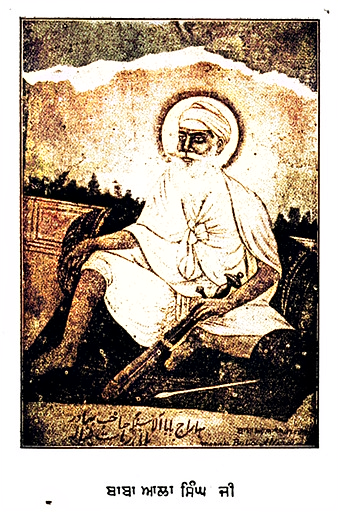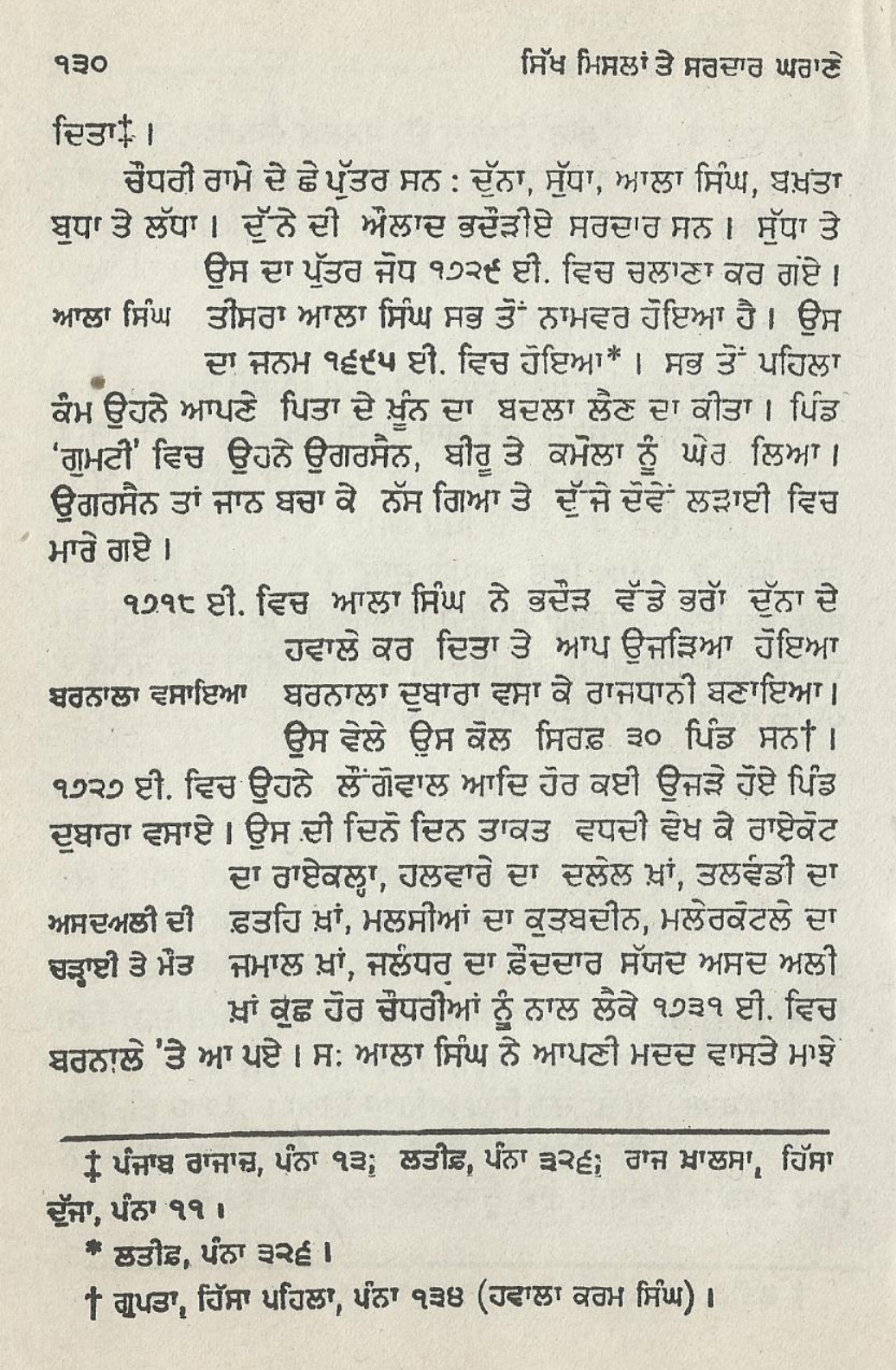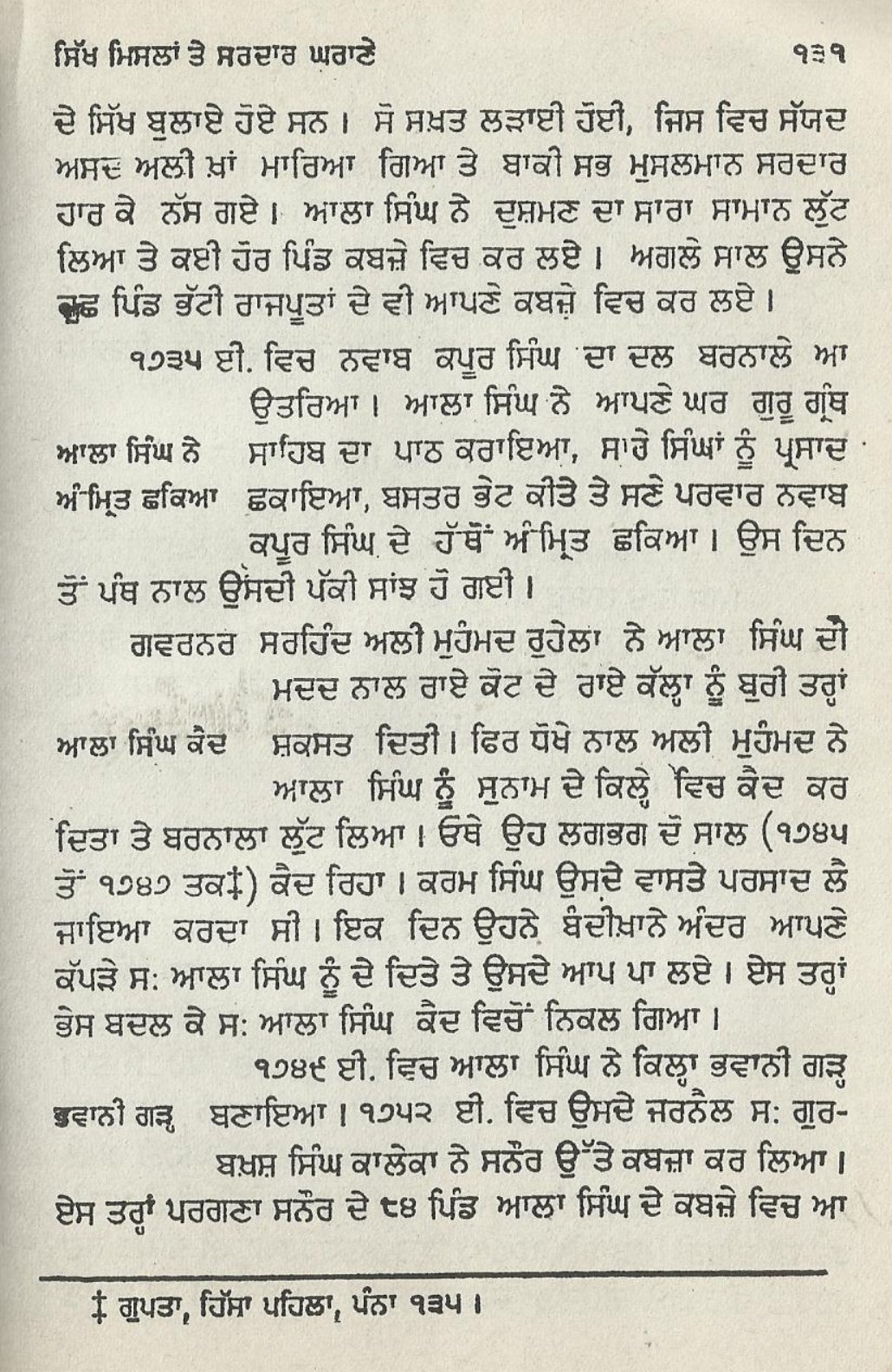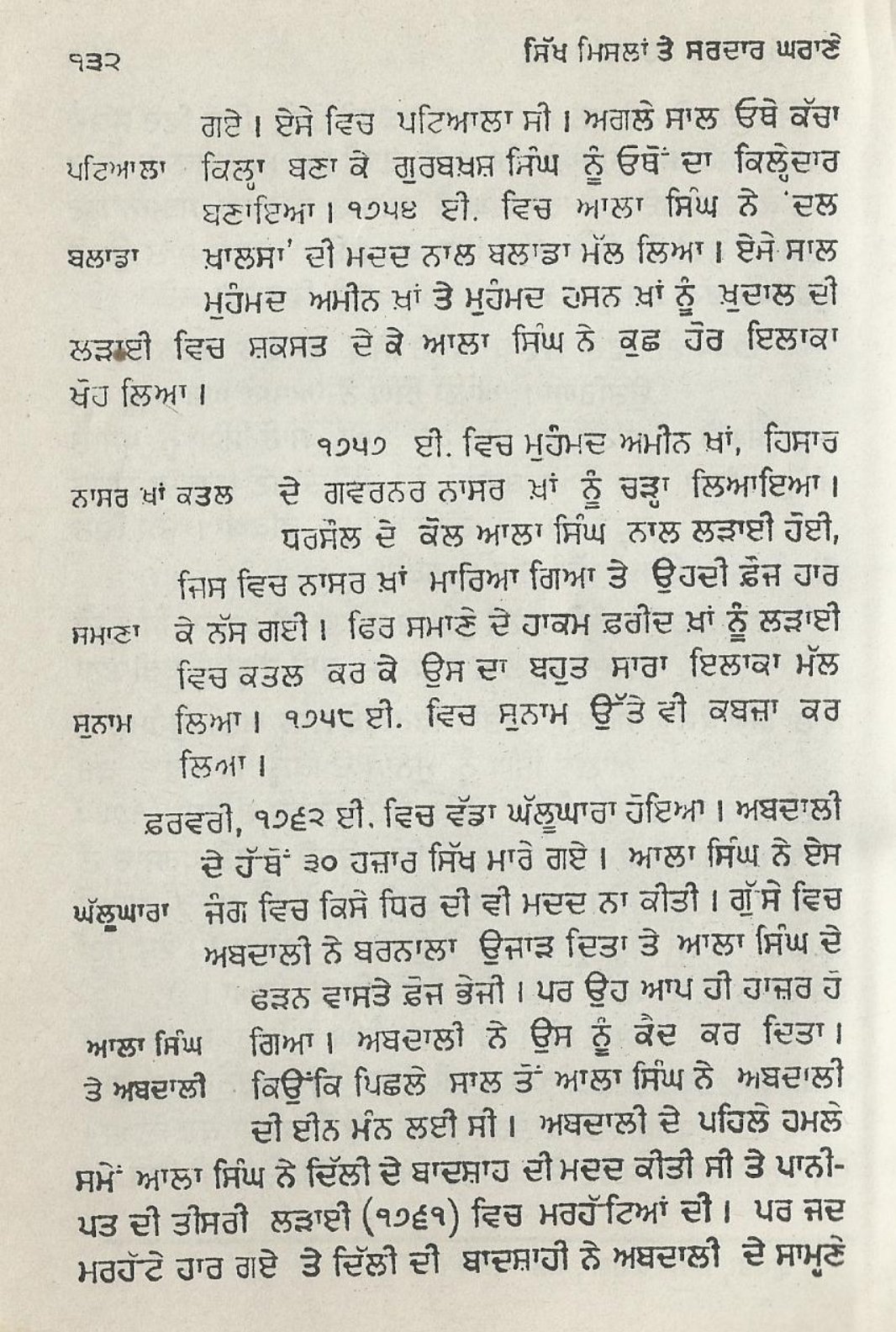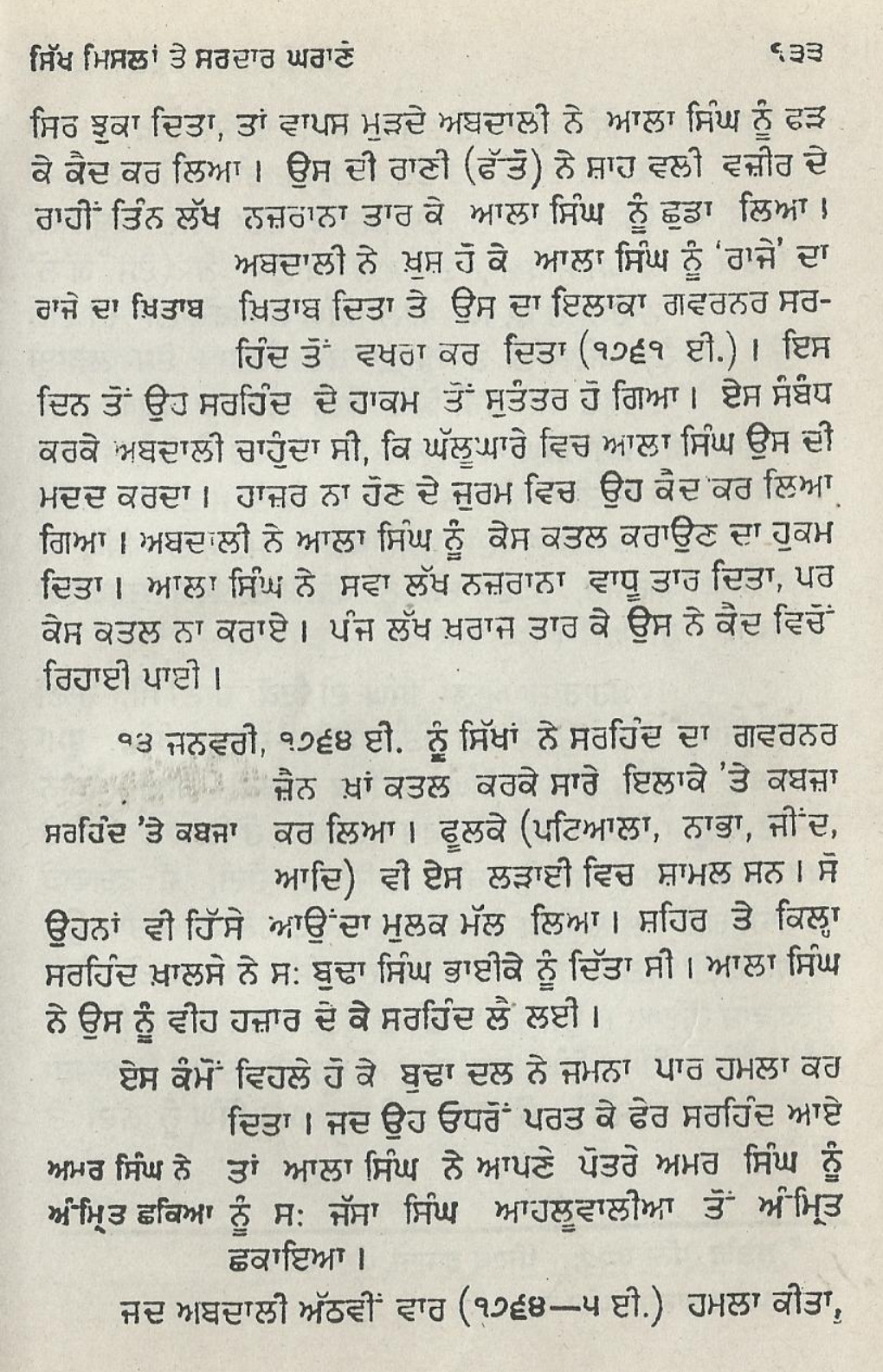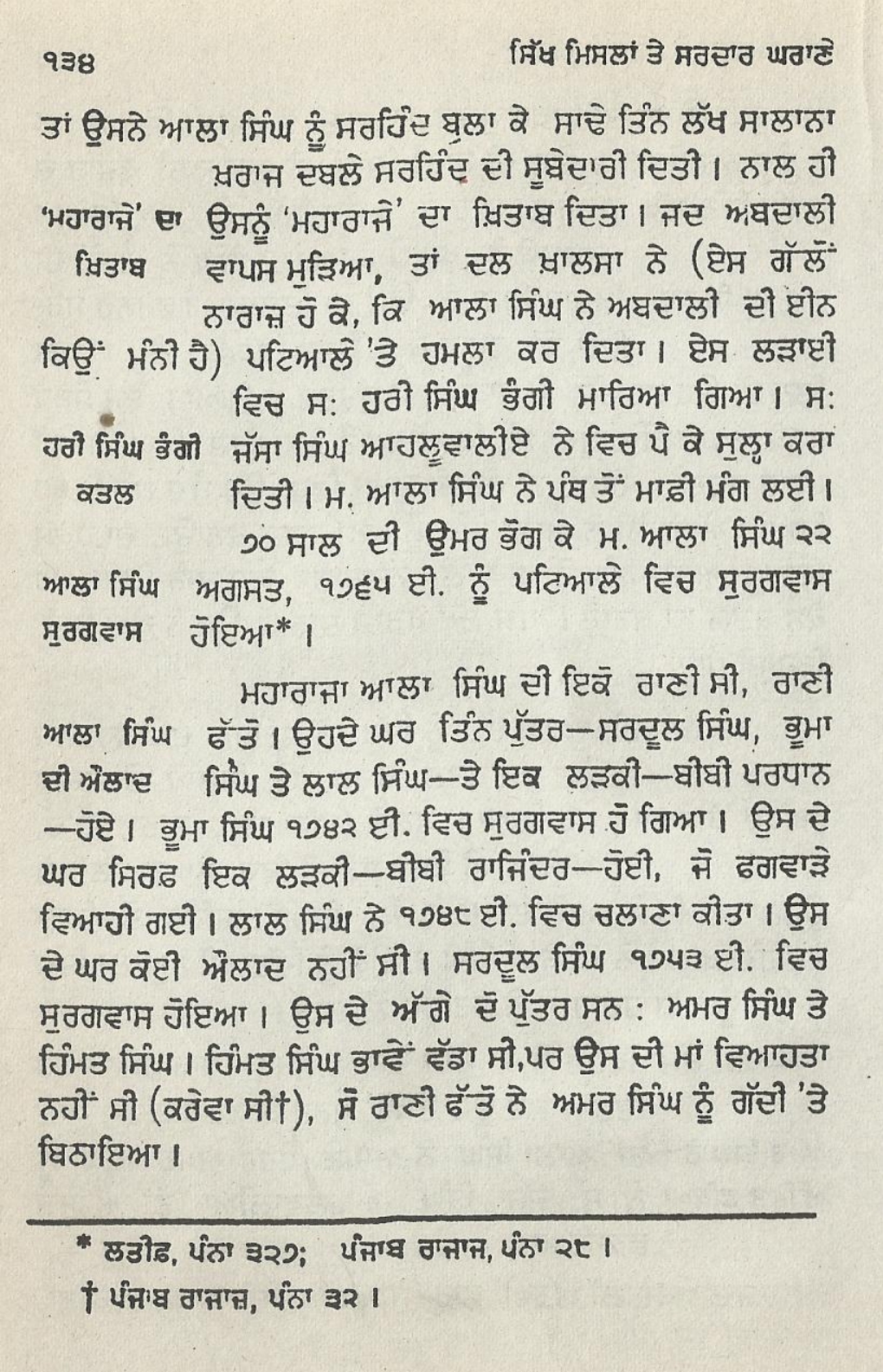|
|
| (18 intermediate revisions by 2 users not shown) |
| Line 1: |
Line 1: |
| '''Maharaja Ala Singh Sidhu''' was born on 5 October 1691 AD in the village of Phool (Which is now in [[Bathinda]] district). He was the son of Sardar Ram Singh. Ala Singh was a prince of the [[Phulkian Misl]]. He built a huge empire because of his bravery. It had an area of 332,000 sq km. His empire was even larger than that of [[Ranjit Singh]].
| | {{protected}}[[File:Raja Ala Singh.png]] |
| [[File:Baba_Ala_Singh.jpg|400px]] | | [[File:1650359121850.jpg]] |
| == Biography ==
| | [[File:1650359122172.jpg]] |
| Ala Singh was born on 5 October 1691 in the village of Phool (district of [[Bathinda]]) to Sardar Ram Singh. His grandfather Chaudhary Phool Singh was the founder of the [[Phulkian Misl]]. Ala Singh's mother's name was Sulakhan Kaur. Sulakhan Kaur was the daughter of Wazir Alam Chand of [[Lahore]].
| | [[File:1650359122486.jpg]] |
| Ala Singh's family belonged to the Sidhu [[Jatt]] caste. His grandfather Phool Singh was blessed by [[Guru Har Rai]], the seventh Guru of the Sikhs. As a result, Phool Singh had become a major feudal lord of the Malwa. He served in the court of Mughal Emperor [[Aurangzeb]] till 1691 AD. Fed up with [[Aurangzeb]]'s tyranny, Phool Singh quit his job. Due to which Phool Singh was martyred in 1691 AD. After Phool Singh, his only son Ram Singh became [[Sardar]]. He received Amrit from [[Guru Gobind Singh]].
| | [[File:1650359122796.jpg]] |
| Ala Singh was the only son of his parents. As a result, he was raised with great care. When Ala Singh was five years old, his grandfather Alam Chand took him to [[Lahore]]. There he received a higher education. Through the efforts of Alam Chand, Ala Singh acquired knowledge of many languages of the Mughal Empire. When he was ten years old, he was trained in martial arts. It is said that Ala Singh had become such a good warrior in his childhood that he once killed a lion. He was only twelve at the time.
| | [[File:1650359123165.jpg]] |
| In 1707 AD, [[Guru Gobind Singh]] went south. He was accompanied by Ala Singh's father, Ram Singh. He handed over his throne to Ala Singh before leaving. Ram Singh predicted that one day my son Ala Singh would become the Maharaja of a very large kingdom. Ala Singh's reign of Tilak took place on 17 October 1707 AD. When he became the chief of the [[Phulkian Misl]], his rule was only over the village. Due to his bravery and ability he established the Patiala Empire.
| |
| ==Personal Life==
| |
| When Ala Singh was 17 years old, relationships began to form for his marriage. At the request of Nanu Singh Saini, a [[Brahmin]] of Sunam, Ala Singh was married to Fateh Kaur, daughter of Chaudhary Charan Singh of [[Barnala]] village. A few months later, Sardul Singh was born. He was the only son of Ala Singh. He later contributed greatly to the expansion of the [[Patiala]] Empire.
| |
| ==Rise of Power==
| |
| '''[[Bathinda]] Victory'''<br>
| |
| After the martyrdom of [[Banda Singh Bahadur]], Ala Singh began to conquer the [[Mughal]] territories. He first won the state of [[Bathinda]]. This state was very important. Apart from this, the fort built here was built by Ala Singh's ancestor. In 1716 AD, Ala Singh invaded [[Bathinda]]. From here Chaudhary reached Mohat Khan [[Lahore]]. Thus, without any action, Ala Singh captured the fort.
| |
|
| |
| '''[[Barnala]] Victory'''<br>
| |
| Chaudhary Mohat Khan of [[Bathinda]] sought the help of Abd al-Samad Khan, Governor of Punjab. The governor sent an army of 10,000 to help Mohat Khan. That is, they defeated Ala Singh's father-in-law Charan Singh and captured Barnala. When Ala Singh was not found out, 7,000 horsemen were sent to [[Barnala]] under the leadership of Nanu Singh Saini. Nanu Singh Saini defeated the Mughal army and drove them to Lahore. Pleased with his action, Ala Singh made him his prime minister. [[Barnala]] was made the capital of the [[Phulkian Misl]].
| |
|
| |
| '''Treaty With Mughal Emperor Muhammad Shah'''<br>
| |
| After the death of [[Aurangzeb]], incompetent rulers like Bahadur Shah I, Jahandar Shah, [[Farrukhsiyar]], Rafi ud-Darajat and Shah Jahan II ruled. In 1719 AD, Muhammad Shah became the Mughal Emperor. He made several attempts to prevent the downfall of the [[Mughal Empire]]. In 1721, he made a treaty with Ala Singh. This is called the Treaty of Flowers. According to which Ala Singh promised to protect the [[Mughals]] from foreign attacks in return for an annual compensation of Rs 50 lakh. Despite the treaty, Ala Singh did not waver from Sikhism. He established his headquarters at [[Barnala]] in 1722 AD. In which the workers robbed the Mughals.
| |
|
| |
| '''The effects of the treaty'''<br>
| |
| In 1739, Nader Shah, the ruler of Iran, invaded [[India]]. He defeated the [[Mughals]] at the Battle of Karnal. While Nader Shah was crossing the [[Sutlej]], Ala Singh attacked him. Nader Shah's caravan was 240 miles long. As a result, he did not have a chance to recover. Ala Singh continued to plunder Nader Shah for many days. Ala Singh gave Rs 50 lakh of the looted money to the [[Mughals]].
| |
| ==Ala Singh as a prisoner==
| |
| In 1745, Nawab Ali Mohammed Khan of Rohilkhand became the governor of [[Sirhind]]. He attacked [[Barnala]] and imprisoned Ala Singh. In 1748, the first invasion of [[India]] was made by [[Ahmed Shah Abdali]], the ruler of [[Afghanistan]]. At that time Ali Mohammed Khan fled to [[Delhi]]. [[Mir Mannu]], son of the Wazir of [[Delhi]], was made Governor of [[Punjab]]. At the same time, Ala Singh was released. In the Battle of Manupur, with the help of Ala Singh, [[Mir Mannu]] defeated [[Ahmed Shah Abdali]]. But Abdali took Ala Singh to [[Lahore]]. There he released Ala Singh for Rs. 5 lakhs and gave him the title of [[Maharaja]].
| |
| ==Member of Dal Khalsa==
| |
| In 1748, [[Nawab Kapur Singh]] founded the [[Dal Khalsa]]. After the death of Zakariya Khan Bahadur]], the [[Dal Khalsa began to rise. Due to his influence, in 1749, Ala Singh was baptized by [[Nawab Kapur Singh]]. He agreed to remain under the [[Dal Khalsa]] forever. Thus Ala Singh became a member of the [[Dal Khalsa]].
| |
| ==Establishment of the [[Patiala]] Empire==
| |
| '''Victory of Tohana (1753 AD)'''<br>
| |
| Tohana was located south-west of Jind. This region was very rich. Here was the kingdom of the rich at that time. The annual income of the rich was Rs 3 crore. There was a long struggle between the [[Mughals]] and [[Ahmad Shah Abdali]] for subjugation of the territory. Ala Singh wanted to subdue Tohana. So he invaded Tohana in 1753 AD. He first defeated the [[Mughal]] army and forced them to flee to [[Delhi]]. Ala Singh then wreaked havoc on the Afghan army. Finally the Mughals and [[Ahmad Shah Abdali]] made a treaty with Ala Singh.According to which Tohana Pradesh and its income were taken over by Ala Singh. Thus the victory of Tohana proved to be very politically and economically beneficial for Ala Singh.
| |
| | |
| '''Victory of Bhatner (1759 AD)'''<br>
| |
| From 1754-1758 AD, Ala Singh took no action. Because at that time Marathas had established their rule in [[Punjab]]. He did not want to clash with the Marathas. In 1759, [[Ahmad Shah Abdali]] invaded the Punjab to teach the Marathas a lesson. Ala Singh took full advantage of the situation and attacked Bhatner. In this fort of this city all the crops of Rajputana were kept. The fighting continued for many days. Sher Chand, ruler of Bhatner, died suddenly. After which Ala Singh captured the fort.Ala Singh did not capture the entire crop of Rajaputana. The farmers agreed to give Ala Singh third part of the crop.
| |
| | |
| '''Victory of Bahawalpur (1760 AD)'''<br>
| |
| In 1760 AD Nawab Bahawal Khan of Bahawalpur province (a province extending from Sialkot to Sindh) lost contact with [[Ahmad Shah Abdali]]. The Nawab thus declared himself independent. Ala Singh was looking for an opportunity. He sent 10,000 troops to defeat Bahawal Khan. This army was severely defeated by Bahawal Khan. Ala Singh himself went to Bahawalpur to conquer it. He defeated Bahawal Khan in a battle outside the fort of Bahawalpur. Ala Singh pardoned Bahawal Khan and re-appointed him governor of Bahawalpur. Engaged in the war against the Marathas, Ahmad Shah Abdali could not pay attention to Ala Singh.
| |
| | |
| '''Victory of Sindh (1761 AD)'''<br>
| |
| In the Third Battle of Panipat (14 January 1761 AD), [[Ahmad Shah Abdali]] wreaked havoc on the Marathas. As a result, the power of the Marathas ended in the Punjab. Taking advantage of this opportunity, Ala Singh wanted to expand his kingdom. So he decided to conquer Sindh. The province of Sindh was the richest region in western [[India]]. At that time Sindh was not ruled by any king. Only the rich made decisions. Ala Singh invaded Sindh in 1761 AD. The amirs placed piles of seals in front of Ala Singh. Ala Singh annexed Sindh to his kingdom through trade pacts with the rich.
| |
| | |
| '''Victory of [[Multan]] (1762 AD)'''<br>
| |
| Encouraged by the conquest of Sindh, Ala Singh decided to conquer Multan. The province of [[Multan]] was not very important but the Iranian invaders came to [[India]] only after crossing it. Muzaffar Khan was the governor of Multan at that time. He was a brave warrior. He received the governorship of [[Multan]] by gifting it to [[Ahmad Shah Abdali]]. Ala Singh sent an army under Diwan Nanu Mall in 1762 AD to conquer [[Multan]]. Muzaffar Khan accepted Ala Singh's submission without any opposition.When Nanu Mal was returning to Barnala, Muzaffar Khan revolted. Ala Singh himself went and crushed the revolt. Muzaffar Khan was pardoned and re-appointed Subedar. Thus [[Multan]] was annexed to the [[Phulkian Misl]]. Encouraged by this victory, Ala Singh established the village of Patti. Which he later made his capital. In time, the city came to be known as Patiala. Due to this, the [[Patiala]] Empire got another name of [[Phulkian Misl]].
| |
| | |
| '''Victory of [[Lahore]] (1762 AD)'''<br>
| |
| In 1762 AD, [[Ahmad Shah Abdali]] launched a surprise attack on the Sikhs at Kup, killing 40,000 [[Sikhs]]. Which is called the Great Ghalughara. Ala Singh wanted to teach Abdali a lesson. But he could not face Abdali directly because [[Ahmad Shah Abdali]] was wreaking havoc during the war. Abdali had wreaked such havoc on the Maratha army that the Marathas could never recover from that catastrophe. So Ala Singh decided to reform Abdali's associates.He first targeted Kabli Mall, the governor of Lahore. He had sided with Abdali during the Great Depression. Ala Singh invaded Lahore in 1762 AD. There was fighting in the city for many hours. Kabli Mall was forced to flee to Abdali's capital, Kandahar. Ala Singh captured the city and annexed the province to the [[Patiala]] Empire. Due to this light, Abdali's power was severely damaged. His power began to decline from the [[Punjab]].
| |
| | |
| '''Victory of Peshawar (1763 AD)'''<br>
| |
| After the conquest of [[Lahore]], Ala Singh decided to conquer the province of Peshawar. It was located northwest of the Indus River. Ala Singh invaded Peshawar in 1763 AD. Jahan Khan, the governor of Kandahar, fled to Kandahar. Ala Singh captured Peshawar. After losing Peshawar, [[Ahmed Shah Abdali]] attacked Peshawar. Fighting continued for several days between Ala Singh and Abdali.Eventually, due to the insurgency in Afghanistan, Abdali made a treaty with Ala Singh. Accordingly, Abdali gave the provinces to Ala Singh, which provinces Ala singh won. After this victory, Ala Singh's empire spread to the Indus River. The Indus River was the western boundary of Ala Singh's empire.
| |
| | |
| '''Victory of Kangra (1763 AD)<br>
| |
| Kangra was a province with East Punjab which extended to Nepal. The ruler of this place, Bihar Chand Katoch, was preparing to attack Patiala. In 1763, while Ala Singh was celebrating the victory of Peshawar, Bihar Chand invaded the [[Punjab]] with one lakh troops. Ram Singh (Ala Singh's father) defeated Bihar Chand in a battle at Ropar. Ala Singh appointed Sansar Chand, son of Bihar Chand, as Subedar. Kangra was annexed to the [[Patiala]] Empire.
| |
| | |
| '''Victory of [[Sirhind]] (1764 AD)'''<br>
| |
| | |
| Ala Singh did not want to attack Sirhind but he had to attack [[Sirhind]]. There were two reasons. Earlier, Jain Khan, the governor of [[Sirhind]], had sided with [[Ahmad Shah Abdali]] during the Great Depression. Secondly, Patiala being situated on the very frontier, Ala Singh wanted to secure Patiala by conquering [[Sirhind]]. So Ala Singh invaded [[Sirhind]] in 1764 AD. From there, Jain Khan was killed. Ala Singh convened a meeting of the Dal Khalsa and discussed [[Sirhind]]. [[Jassa Singh Ahluwalia]] handed over the province of [[Sirhind]] to Ala Singh.This victory is last victory of Ala Singh.
| |
